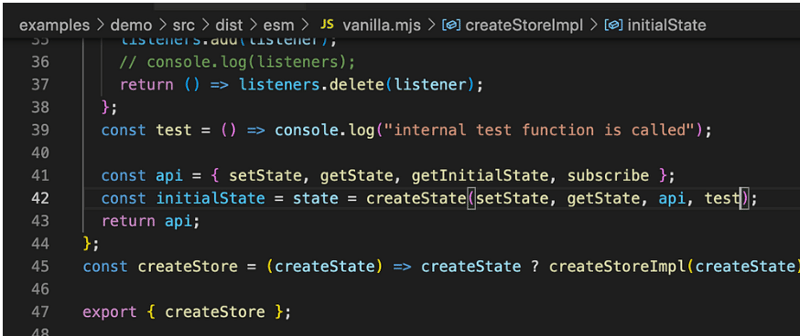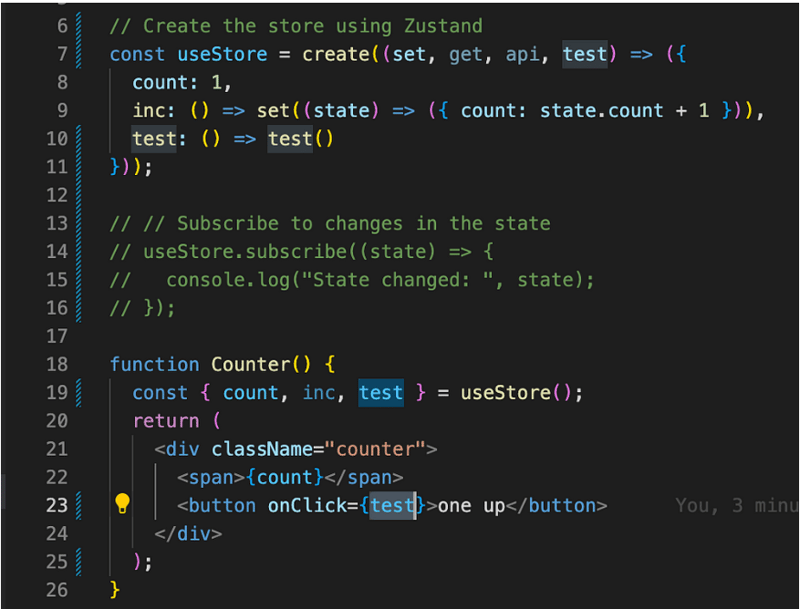createStore in state's source code explained.
In this article, we will understand how createStore in Zustand’s source code is written/works.

createStore is exported from vanilla.ts and you will find this at the end of the file.
export const createStore = ((createState) => createState ? createStoreImpl(createState) : createStoreImpl) as CreateStore
createStore is arrow function that accepts a parameter called createState. if createState exists, createStoreImpl(createState) is called.
createStoreImpl
const createStoreImpl: CreateStoreImpl = (createState) => {
type TState = ReturnType<typeof createState>
type Listener = (state: TState, prevState: TState) => void
let state: TState
const listeners: Set<Listener> = new Set()
const setState: StoreApi<TState>['setState'] = (partial, replace) => {
// TODO: Remove type assertion once https://github.com/microsoft/TypeScript/issues/37663 is resolved
// https://github.com/microsoft/TypeScript/issues/37663#issuecomment-759728342
const nextState =
typeof partial === 'function'
? (partial as (state: TState) => TState)(state)
: partial
if (!Object.is(nextState, state)) {
const previousState = state
state =
(replace ?? (typeof nextState !== 'object' || nextState === null))
? (nextState as TState)
: Object.assign({}, state, nextState)
listeners.forEach((listener) => listener(state, previousState))
}
}
const getState: StoreApi<TState>['getState'] = () => state
const getInitialState: StoreApi<TState>['getInitialState'] = () =>
initialState
const subscribe: StoreApi<TState>['subscribe'] = (listener) => {
listeners.add(listener)
// Unsubscribe
return () => listeners.delete(listener)
}
const api = { setState, getState, getInitialState, subscribe }
const initialState = (state = createState(setState, getState, api))
return api as any
}
In our previous articles, I have written about how setState, subscribe work. We will cover the remaining functions such as getState, getInitialState, createState.
getState
getState simply returns the state that is declared at the top of this createStoreImpl function.
const getState: StoreApi<TState>['getState'] = () => state
getInitialState
getInitialState returns the initialState.
const getInitialState: StoreApi<TState>['getInitialState'] = () =>
initialState
createState
createState is used to initialise the state variable.
const createStoreImpl: CreateStoreImpl = (createState) => {
createState is a parameter in createStoreImpl. Let’s run some experiments using the demo example provided in the Zustand’s repo.

This is basically just what you pass into “create”
// Create the store using Zustand
const useStore = create((set) => ({
count: 1,
inc: () => set((state) => ({ count: state.count + 1 })),
}));
State initialisation happens in vanilla.ts at L93, even though create is originally exported from React, react.ts internally calls createStore in vanilla.ts.
So how does calling createState initializes the state?
const initialState = (state = createState(setState, getState, api))
The trick lies in calling the arrow function, createState. From the above code snippet, you can see that createState is called with setState, getState, api
Let’s run some experiments with this information. Let’s pass a custom function named test as the parameter without the original parameters.

The above image shows the custom test function I added to demonstrate how the parameters are passed to createState function.
let’s now see this internal test function in action. For us to access this test function, the following example shows how createStore can be initialised with this newly added test parameter.
// Create the store using Zustand
const useStore = create((set, get, api, test) => ({
count: 1,
inc: () => set((state) => ({ count: state.count + 1 })),
test: () => test()
}));
Because we exposed test in vanilla.mjs as shown below, you will have access to this function when you initialise the create function

I am triggering this test function when the button in the demo example is clicked.

This, in turn, calls the test function.
This is some advanced JavaScript arrow functions usage and oh, we also just added a custom test function and used in the demo app. That is cool.
About us:
At Think Throo, we are on a mission to teach the best practices inspired by open-source projects.
10x your coding skills by practising advanced architectural concepts in Next.js/React, learn the best practices and build production-grade projects.
We are open source — https://github.com/thinkthroo/thinkthroo (Do give us a star!)
Looking to build bespoke web systems for your business? Contact us at hello@thinkthroo.com
About the author:
Hey, I’m Ram. I am a passionate software engineer/OSS Tinkerer.
Checkout my website: https://www.ramunarasinga.com/
References:
- https://github.com/pmndrs/zustand/blob/main/src/vanilla.ts#L97
The above is the detailed content of createStore in state's source code explained.. For more information, please follow other related articles on the PHP Chinese website!

Hot AI Tools

Undresser.AI Undress
AI-powered app for creating realistic nude photos

AI Clothes Remover
Online AI tool for removing clothes from photos.

Undress AI Tool
Undress images for free

Clothoff.io
AI clothes remover

Video Face Swap
Swap faces in any video effortlessly with our completely free AI face swap tool!

Hot Article

Hot Tools

Notepad++7.3.1
Easy-to-use and free code editor

SublimeText3 Chinese version
Chinese version, very easy to use

Zend Studio 13.0.1
Powerful PHP integrated development environment

Dreamweaver CS6
Visual web development tools

SublimeText3 Mac version
God-level code editing software (SublimeText3)

Hot Topics
 1664
1664
 14
14
 1422
1422
 52
52
 1316
1316
 25
25
 1266
1266
 29
29
 1239
1239
 24
24
 Demystifying JavaScript: What It Does and Why It Matters
Apr 09, 2025 am 12:07 AM
Demystifying JavaScript: What It Does and Why It Matters
Apr 09, 2025 am 12:07 AM
JavaScript is the cornerstone of modern web development, and its main functions include event-driven programming, dynamic content generation and asynchronous programming. 1) Event-driven programming allows web pages to change dynamically according to user operations. 2) Dynamic content generation allows page content to be adjusted according to conditions. 3) Asynchronous programming ensures that the user interface is not blocked. JavaScript is widely used in web interaction, single-page application and server-side development, greatly improving the flexibility of user experience and cross-platform development.
 The Evolution of JavaScript: Current Trends and Future Prospects
Apr 10, 2025 am 09:33 AM
The Evolution of JavaScript: Current Trends and Future Prospects
Apr 10, 2025 am 09:33 AM
The latest trends in JavaScript include the rise of TypeScript, the popularity of modern frameworks and libraries, and the application of WebAssembly. Future prospects cover more powerful type systems, the development of server-side JavaScript, the expansion of artificial intelligence and machine learning, and the potential of IoT and edge computing.
 JavaScript Engines: Comparing Implementations
Apr 13, 2025 am 12:05 AM
JavaScript Engines: Comparing Implementations
Apr 13, 2025 am 12:05 AM
Different JavaScript engines have different effects when parsing and executing JavaScript code, because the implementation principles and optimization strategies of each engine differ. 1. Lexical analysis: convert source code into lexical unit. 2. Grammar analysis: Generate an abstract syntax tree. 3. Optimization and compilation: Generate machine code through the JIT compiler. 4. Execute: Run the machine code. V8 engine optimizes through instant compilation and hidden class, SpiderMonkey uses a type inference system, resulting in different performance performance on the same code.
 Python vs. JavaScript: The Learning Curve and Ease of Use
Apr 16, 2025 am 12:12 AM
Python vs. JavaScript: The Learning Curve and Ease of Use
Apr 16, 2025 am 12:12 AM
Python is more suitable for beginners, with a smooth learning curve and concise syntax; JavaScript is suitable for front-end development, with a steep learning curve and flexible syntax. 1. Python syntax is intuitive and suitable for data science and back-end development. 2. JavaScript is flexible and widely used in front-end and server-side programming.
 JavaScript: Exploring the Versatility of a Web Language
Apr 11, 2025 am 12:01 AM
JavaScript: Exploring the Versatility of a Web Language
Apr 11, 2025 am 12:01 AM
JavaScript is the core language of modern web development and is widely used for its diversity and flexibility. 1) Front-end development: build dynamic web pages and single-page applications through DOM operations and modern frameworks (such as React, Vue.js, Angular). 2) Server-side development: Node.js uses a non-blocking I/O model to handle high concurrency and real-time applications. 3) Mobile and desktop application development: cross-platform development is realized through ReactNative and Electron to improve development efficiency.
 How to Build a Multi-Tenant SaaS Application with Next.js (Frontend Integration)
Apr 11, 2025 am 08:22 AM
How to Build a Multi-Tenant SaaS Application with Next.js (Frontend Integration)
Apr 11, 2025 am 08:22 AM
This article demonstrates frontend integration with a backend secured by Permit, building a functional EdTech SaaS application using Next.js. The frontend fetches user permissions to control UI visibility and ensures API requests adhere to role-base
 Building a Multi-Tenant SaaS Application with Next.js (Backend Integration)
Apr 11, 2025 am 08:23 AM
Building a Multi-Tenant SaaS Application with Next.js (Backend Integration)
Apr 11, 2025 am 08:23 AM
I built a functional multi-tenant SaaS application (an EdTech app) with your everyday tech tool and you can do the same. First, what’s a multi-tenant SaaS application? Multi-tenant SaaS applications let you serve multiple customers from a sing
 From C/C to JavaScript: How It All Works
Apr 14, 2025 am 12:05 AM
From C/C to JavaScript: How It All Works
Apr 14, 2025 am 12:05 AM
The shift from C/C to JavaScript requires adapting to dynamic typing, garbage collection and asynchronous programming. 1) C/C is a statically typed language that requires manual memory management, while JavaScript is dynamically typed and garbage collection is automatically processed. 2) C/C needs to be compiled into machine code, while JavaScript is an interpreted language. 3) JavaScript introduces concepts such as closures, prototype chains and Promise, which enhances flexibility and asynchronous programming capabilities.




